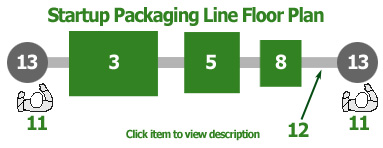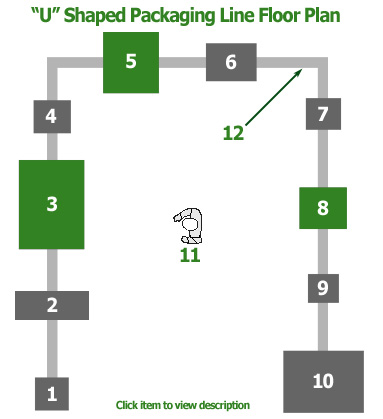When it comes to packaging machinery, just about anything can be made to automate your product line. The basic differences between packaging machines are the cost, quality, and reliability. A machine that cost less might end up costing more in the long run. It might stop working more often, require more maintenance or change over time, and even have to require an employee to monitor the equipmentt all the time. Another factor to consider when planning your packaging line is to purchase equipment from companies that are experts in making a particular type of machine. You do not want to buy a filling machine from a company that makes case packers! This is like buying a Ford at a Caterpillar outlet. Buy from the experts. A good company has startup semi-automatic low cost machines to fully automatic top of the line equipment.

Startup Packaging Line Floor Plan
The Startup line has the basic equipment (Filler, Capper, & Labeler) to automate a packaging line. By having a Turn Table on each end of the line you can give the operators more time to load and unload the components. This setup is recommended for dedicated lines that go through very minimal adjustments to the machinery. The more change overs you have, the more problems you may run into, so buy equipment with "No tool" and "Lean Changeover" designs built into the equipment.

"U" Shaped Packaging Line Floor Plan
The "U" Shaped line is designed to have few operators run the entire line. As you can see, the product starts with a bottle unscrambler and ends with the finish product in the case. The other benefit is safety since the product is loaded and unloaded from one side. If you have the space available or if you are building a new production line we recommend you use this design. If your budget does not allow the purchase of all the equipment at one time then invest in a modular "U" shaped conveyor and add the equipment as the need arise. The engineers at Lazar Capper can advise on you on the conveyor and equipment avaialble for your production line.
At the start of the line you need to place empty containers onto the conveyor. This requires one or more operators to grab empty containers from a box and orient them in the upright position on the conveyor. This can all be done with a Bottle Unscrambler. These machines can take up quite a bit of floor space depending on the size of your containers. This is because in order to make the machine practical it should have a hopper sized enough to hold about one hour worth of containers. This is a great machine to purchase for your line if you are running at high speeds and have minimal change overs. This machine requires an operator to empty boxes of containers into the hopper.
Depending on what your product is you might require the bottle to be cleaned before filling your substance. This can be done with a Bottle Cleaner machine. These machines usually orient the bottle upside down and blow either air, water, or steam through the bottom so particles can fall down and out. This machine is usually large in size perpendicular to the conveyor because of the rotary disc required to flip the bottle upside down. Depending on the machine style, It may require a separate disc for each bottle.
In order to fill your product into a container you need a Filling machine. The first consideration is the product and container size. the second factor to consider is the speed required. There are a wide variety of Filling machines because of the many different products. For example you may have a tablet, liquid or powder filler or a specialty filler for your particular product. The two basic fillers are Inline or Rotary style fillers. the later is usually faster and more expensive.
If you are experiencing finished products with obvious different fill heights or your company has upgraded the quality standards. You might need to invest in a Filler Detection Unit. This unit can be done with simple sensors, check by weight or elaborate vision camera systems. For filling detection, a checkweighter is usually the best option. The price and type of the unit depends on how many different components you need to be inspected. The more components you need to verify the more difficult the task and the higher the price.
If one of your machines are having trouble when two containers run back to back. You might want to consider purchasing a Bottle Spacing Unit. These units will add a variable distance between each component to eliminate any components that are running back to back. They also can slow down the flow of components leaving one machine and entering another. You will usually see a Spacing Unit before capping, labeling application or for component inspection. for more information, check out the Lazar Spacing Unit.
After your component is filled with its substance you want to seal it up. To do this, you need a Capping machine. Capping machines come in three different distinct styles: Inline, Chuck, & Rotary. Chuck Cappers run at low speeds 0-60 Caps Per Minute (CPM) and function by stopping the bottle, holding it, and capping it. Inline Cappers run at higher speeds from 0-350 CPM and with some components up to 600 CPM. The inline cappers use the bottle or container to pick the cap and run straight through several sets of opposing wheels to place it and torque it without stopping. Rotary Cappers run high speeds from 0-1200 CPM and function by diverting the component via a set of starwheels onto a large rotary disc where it caps it and returns it to the conveyor. Rotary cappers are usually two to three times more expensive and require one set of changeparts for each cap/bottle. In addition the rotary capper takes longer to changeover.
If your product requires tamper evidence, freshness, or leak prevention you might need to consider an Induction Sealer. Induction Sealers use a magnetic field to heat the foil and stick it to the container. The components and speed of the line depend on which sealer to purchase.
If you are finding that your cap is loose down the line you might want to consider a Retorquer. A Retorquer basically Re - Torques a cap onto the bottle. You might experience loose caps after an Induction Sealer machine. A Retorquer can also be used as a semi-automatic capper if you have someone already placing the caps on the bottle. The machines are usually small in size and low priced.
If you need to put labels on your product you will need to purchase a Labeler. The machine you purchase here will depend on the type of bottle and label used. If you have multiple components requiring different labels you might need multiple labelers and have one bypassed during production.
If you find that bottles are passing the labeler without labels you might need to consider a Label Detection Unit. This unit can be simple or very complex depending on how many different components you are inspecting. When a bad component is verified the detection unit can either alarm or send the component to a rejection conveyor. This is also a good spot to do bar code reading or gain information about the product being run.
At the end of the line you need to grab the bottles, arrange them into a box, and seal the box. This can all be automated with a Case Packer. This machine is ideal if you are running a dedicated line. If you are running multiple components on one line the case packer might require large change overs. These machines are usually custom to each application because of all the variable involved.
Depending on how many machines you have and how good these machines work will determine how many operators you need. In a "U" Shaped design you can have one operator easily monitor several machines. This task is a little more complicated when you have a straight line like the startup line shown above. You also might need extra operators just to monitor a machine that doesn't work like it should. This is why it is important to research and know which machinery you are buying. A lower costing machine might cost more when you have to hire an operator with health insurance and a salary. A lower costing machine might also require more maintenance and longer change over times which means production downtime.
A conveyor has the simple job of moving the product throughout the line. We recommend that you try to purchase all your conveyors from the same place in order to keep them uniform. Conveyor techniques will be explained in the next chapters.
A Turn Table or accumulating table can be designed to feed components into a conveyor or accept components and keep them on the table. They are usually used at the start and finish of a packaging line. Turn Tables give the operator a little extra time to complete there job without having to keep up with the rate of the machines. The size of the Turn Table depends on the component size and how much time needed for the operator.